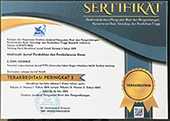Analysis of Difficulty of PGSD Students in Making Research Instruments
Abstract
Keywords
Full Text:
PDFReferences
April, S. (2019). Meningkatkan Kemampuan Guru Dalam Menyusun Kisi-Kisi Soal Dengan Metode Pendampingan Pola “OCF” di SDN Yanti Jogoroto. Jurnal Dinamika Manajemen Pendidikan, 4(1), 17. https://doi.org/10.26740/jdmp.v4n1.p17-24.
Hardt, J., Herke, M., & Leonhart, R. (2012). Auxiliary variables in multiple imputation in regression with missing X: A warning against including too many in small sample research. BMC Medical Research Methodology, 12, 1–13. https://doi.org/10.1186/1471-2288-12-184.
Iskandar. 2008. Metodologi Penelitian Pendidikan dan Sosial (Kuantitatif dan Kualitatif). Jakarta: Gaung Persada Press. Hlm 79.
Kimberlin, C. L., & Winterstein, A. G. (2008). Validity and reliability of measurement instruments used in research. American Journal of Health-System Pharmacy, 65(23), 2276–2284. https://doi.org/10.2146/ajhp070364.
Lastuti, S. (2017). Analisis Kesulitan Mahasiswa Pgsd Dalam Menyusun Instrumen Penilaian (Ranah Afektif Dan Kognitif). Jurnal Pendidikan Mipa, 7(1), 75–79.
Michael T. French, I. P. (2011). Editorial Identification Of Treatment Effects. Health Economics, 20, 127–146. Https://Doi.Org/Https://Doi.Org/10.1002/Hec.1572.
Nasution, S. (2017). Variabel penelitian. Raudhah, 05(02), 1–9.
Patrick, D. L., Burke, L. B., Gwaltney, C. J., Leidy, N. K., Martin, M. L., Molsen, E., & Ring, L. (2011). Content validity - Establishing and reporting the evidence in newly developed patient-reported outcomes (PRO) instruments for medical product evaluation: ISPOR PRO good research practices task force report: Part 1 - Eliciting concepts for a new PRO instru. Value in Health, 14(8), 967–977. https://doi.org/10.1016/j.jval.2011.06.014.
Pike, G. R., Hansen, M. J., & Lin, C. H. (2011). Using Instrumental Variables to Account for Selection Effects in Research on First-Year Programs. Research in Higher Education, 52(2), 194–214. https://doi.org/10.1007/s11162-010-9188-x.
Riduwan, Skala Pengukuran Variabel-variabel Penelitian, Alfabeta, 2010, hlm 5.
Rismen, S. (2015). Analisis kesulitan mahasiswa dalam penyelesaian skripsi di Prodi Pendidikan Matematika STKIP PGRI. Lemma, I(2), 57–62. Retrieved from ejournal.stkip-pgri-sumbar.ac.id/index.php/jurnal-lemma/article/view/538.
Ristiyani, E., & Bahriah, E. S. (2016). Analisis Kesulitan Belajar Kimia Siswa Di Sman X Kota Tangerang Selatan. Jurnal Penelitian Dan Pembelajaran IPA, 2(1), 18. https://doi.org/10.30870/jppi.v2i1.431.
Rowley, J. (2012). Conducting research interviews. Management Research Review, 35(3–4), 260–271. https://doi.org/10.1108/01409171211210154.
Sartika, D., & Humairah, N. A. (2017). Analisis Kesulitan Memecahkan Masalah pada Mata Kuliah Fisika Modern Mahasiswa Calon Guru Fisika. 7(1), 7–11.
Slavin, R. E. (1980). Cooperative Learning. Review of Educational Research, 50(2), 315–342. https://doi.org/10.3102/00346543050002315.
Suharsimi Arikunto. Prosedur Penelitian Suatu Pendekatan Praktik .Rineka cipta Jakarta 2006 hlm 118.
Suharsimi Arikunto. 2000. Manajemen Penelitian. Jakarta: Rineka Cipta.
Talmy, S. (2010). Qualitative interviews in applied linguistics: From research instrument to social practice. Annual Review of Applied Linguistics, 30, 128–148. https://doi.org/10.1017/S0267190510000085.
Williams, L. J., & McGonagle, A. K. (2016). Four Research Designs and a Comprehensive Analysis Strategy for Investigating Common Method Variance with Self-Report Measures Using Latent Variables. Journal of Business and Psychology, 31(3), 339–359. https://doi.org/10.1007/s10869-015-9422-9.
Yusup, F. (2018). Uji Validitas dan Reliabilitas Instrumen Penelitian Kuantitatif. Jurnal Tarbiyah : Jurnal Ilmiah Kependidikan, 7(1), 17–23. https://doi.org/10.18592/tarbiyah.v7i1.2100.
Zainal Arifin. 2012. Penelitian Metode dan Paradigma Baru. Bandung: PT Remaja Rosdakarya. Hal. 2.
Zartler, U. (2010). Multiple perspectives in qualitative family research: Crafting and conducting research projects. Family Science, 1(3–4), 173–182. https://doi.org/10.1080/19424620.2010.569371.
Zulkifli Matondang. (2009). Validitas dan Reliabilitas Suatu Instrumen Penelitian. Jurnal Tabularasa PPS Unimed, 6(1), 87–97.
DOI: https://doi.org/10.18860/mad.v14i2.11390
Copyright (c) 2022 Madrasah: Jurnal Pendidikan dan Pembelajaran Dasar

This work is licensed under a Creative Commons Attribution-NonCommercial-ShareAlike 4.0 International License.






